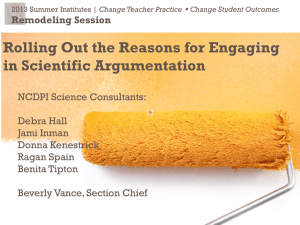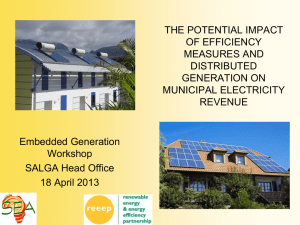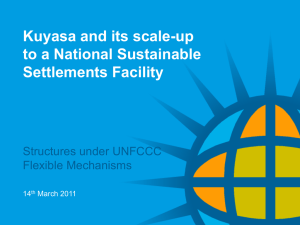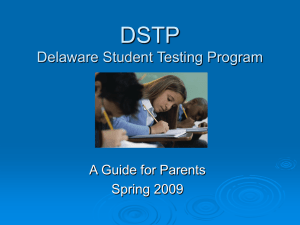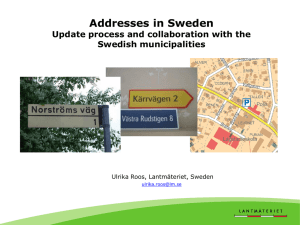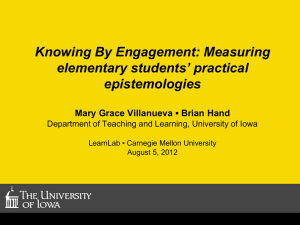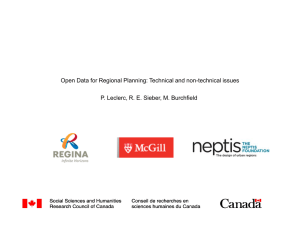Municipalities & National SWH Programme
advertisement
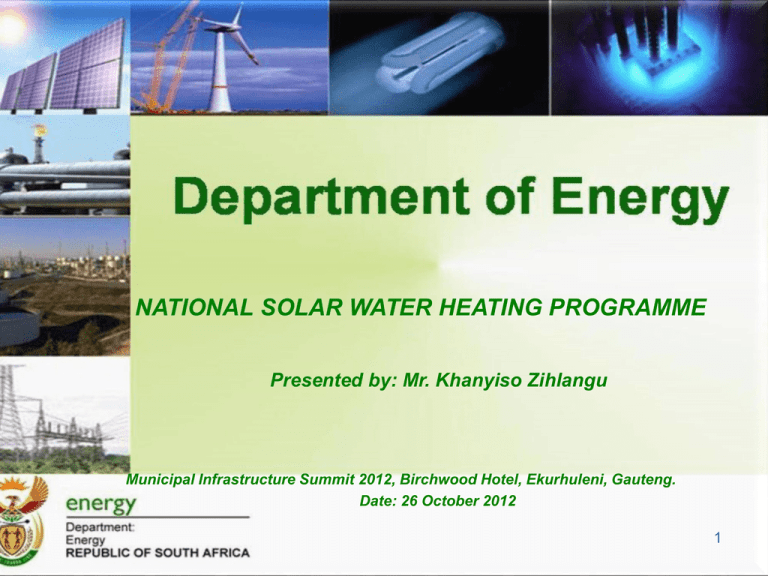
NATIONAL SOLAR WATER HEATING PROGRAMME Presented by: Mr. Khanyiso Zihlangu Municipal Infrastructure Summit 2012, Birchwood Hotel, Ekurhuleni, Gauteng. Date: 26 October 2012 1 Overview of the RSAOUTLINE electricity industry sources of power 1. INTRODUCTION 2. PROGRAMME OBJECTIVES 3. INSTALLATIONS UPDATE 4. LESSONS LEARNED 5. PROGRAMME IMPLEMENTATION STATUS 6. SOME FREQUENTLY ASKED QUESTIONS 7. MUNICIPALITIES INVOLVEMENT 8. CLOSING REMARKS 2 1. INTRODUCTION 3 Commitment, Funding, Expected Outputs DoE’s SWH commitment: • The Department of Energy (DoE) remains resolute in its commitment to ensure that 1 million SWHs are installed in SA by the close of the 2014/15 financial year. Available funding: • The funding allocation (R4.7bn) announced by the Finance Minister during the 2012 Budget Speech is a clear indication of the Government’s commitment to achieving the stated SWH target. Some expected programme outputs: • Amount of energy saved (TWh) & demand reduced (MW); Tons of carbon saved; Number of SWHs installed; Number & types of jobs created; Amount of local content achieved; etc. 4 2. PROGRAMME OBJECTIVES 5 Both Macro-economic & Electricity Supply-Demand Balancing Some Government’s SWH Objectives: • Contribute towards reducing electricity usage attributed to water heating; • Contribute towards the reduction of unwanted greenhouse gas emissions; • Cushion the poor from the rising electricity prices; • Widen residential access to hot water, through SWH, in South Africa; • Facilitate the creation of large scale SWH equipment manufacturing in South Africa; • Create jobs particularly within benefitting communities; and • Contribute towards improving local skills. SWH contribution towards achieving the Government’s broader developmental objectives 6 3. INSTALLATIONS UPDATE 7 Provincial Footprint of Installations PAID & RECEIVED INSTALLATIONS: JAN'08 - 05 OCT'12 350,000 303,986 300,000 250,000 200,000 150,000 87,659 100,000 50,000 28,651 2,889 7,435 8,644 42,502 52,464 61,277 33,776 12,465 0 8 4. LESSONS LEARNED 9 A Case of DoE-Funded Projects (Part I) Key lessons for the DoE: • In implementing the fiscus-funded projects, invaluable lessons have been drawn and are regarded as central to a successful SWH programme rollout going forward. • Planning is the key to a successful programme. Experience that can be drawn from the previous projects: • Conducting a quick scan of a targeted area to assess the appropriateness of installing SWHs in the area should be an integral part of the programme rollout. • The quick scan should be followed by a detailed feasibility study that confirms aspects such as water reticulation status (water connections inside the dwellings), roof integrity, security of water supplies, drainage, orientation of houses, skills set of the area, etc. 10 A DoE-Funded Projects Case (Part II) Experience that can be drawn from the previous projects: (cont’) • Whoever undertakes site assessment must have enough technical strength to properly evaluate a site for application of SWH. • Adherence to product and installation standards should be maintained at all times. • Measures must be put in place to monitor installations real time; • Training of all members of the team (installers, inspectors, sales) is vital. • Only plumbers with relevant SWH installation skills must supervise SWH installations and certify installed systems so as to hold the certifying plumbers liable for any sub-standard work. 11 A DoE-Funded Projects Case (Part III) Experience that can be drawn from the previous projects: (cont’) • The relatively small size of the South African market cannot support a proliferation of highly varied SWH technologies. • To create opportunities for small-scale companies whilst enabling localisation of the SWH technology, contracts for Suppliers, Installers, and Maintainers must be separated. • Demand can be created by providing information and education (grass-roots publicity) about the benefits of the technology to homeowners particularly the high-use electric water heating customers. 12 5. PROGRAMME IMPLEMENTATION STATUS 13 Key Programme Implementation Milestones (Part I) Programme funding legislation: • SWH funds have been exclusively and specifically appropriated to Eskom via the DoE Vote – Appropriation Act, 2012 (Act No. 12 of 2012). Inter-Governmental coordination: • Cabinet mandated SWH Project Steering Committee was set up. • Municipalities’ participation in the PSC is meant to be facilitated through SALGA as one of the participants. Transitional arrangements in place: • Currently rolling out the remnants of the DoE-funded projects (under the previous MTEF allocation). • Rebate programme is set to continue until end Dec’12. • To introduce a differentiated rebate until the new approach gains momentum. 14 Key Programme Implementation Milestones (Part II) Contractual arrangements: • Signing of the DoE-Eskom funding contract is imminent. SWH Request for Information: • The DoE urges municipalities to promptly respond to an RFI issued & placed on the departmental website on 22 October 2012. • RFI objectives: Assess households’ SWH readiness to participate in the programme, and to guide tentative allocations of SWH units to municipalities which will later be confirmed after conducting detailed feasibility studies. Facilitating localisation of the SWH technology: • the dti has completed in investigation into the feasibility of SWH Industry Designation – a legal instrument for setting minimum local content thresholds. 15 Key Programme Implementation Milestones (Part III) Education, awareness & information dissemination: • To be led by the DoE in collaboration with its Partners (beneficiary municipalities, Eskom, SANEDI, GIZ, participating supply & installation companies, communities, et al.). SWH monitoring system: • Developing a web-based (real-time) SWH installations and performance monitoring system through the German Agency for Technical Cooperation (GIZ) support. Conclusion of programme implementation planning: • The Department is at the terminal stages of fully executing the programme and is determined to only allow bulk procurement (for economies of scale benefit ) of systems that have been approved by the South African Bureau of Standards. 16 6. SOME FREQUENTLY ASKED QUESTIONS 17 Persistent Questions (Part I) How can municipalities access the DoE funds? • Municipalities need to submit the data requested through the RFI; • This FY, the DoE will make allocations on the basis of the received household data as well as the need to redress the imbalanced provincial & municipal spread of current installations. • As the municipalities’ capacity to deal with SWH develops, a process of applying for funds will be clearly communicated. What criteria are likely to be used for municipal allocations? • Over and above the socio-economic status of a municipality, other considerations could be those issues that indicate, at face value, the applicability of the SWH technology in an area selected by the municipality – refer to the RFI Questionnaire. 18 Persistent Questions (Part II) • Funds permitting, the 1st prize for the DoE is to switch every household to SWH in a selected area. If not, indigents will be prioritised. Who will be responsible for the procurement of SWHs? • As mandated by the 2012 Appropriation Act, Eskom will be the programme Procurer up until such time the funding legislation proposes otherwise or the entire EEDSM Institutional Arrangements, once finalised, change the participants’ roles. • Eskom will implement the programme under supervision of the DoE and the PSC. Who receives and addresses SWH enquiries at the DoE? • Departmental officials listed on the SWH RFI document are Mr. Xolile Mabusela, Mr. Khanyiso Zihlangu, & Mr. Maphuti Legodi. • Further, emails can be sent to swhprogramme@energy.gov.za. 19 7. MUNICIPALITIES INVOLVEMENT 20 What can Municipalities do? What can Municipalities do to aid the national SWH rollout? • Select SWH ready areas in line with their priorities; • Select targeted beneficiaries if not every household can be connected to SWH; • Provide inputs into the feasibility study; • Ensure that all SWH components used by suppliers are indeed on the municipalities’ list of permitted plumbing components; • Assist with selecting local labour through community structures; • Mobilise & support local SMMEs & Cooperatives to be able to actively participate in the programme; • Build their internal capacities such that they become equal participants in the country's EEDSM drive; and • Review and support the marketing and communication activities 21 8. CLOSING REMARKS 22 Brighter Future ahead for the South African SWH Sector • South African SWH landscape is changing and this presents a significant opportunity for municipalities to play a key role which will be firmed up together with municipalities. • Within a short period of time, municipalities will need to build internal capacity to be able to seize the anticipated SWH opportunities. • So long, the DoE humbly urges municipalities not to appoint or mandate service providers (conclude MoUs) to implement SWH in their areas particularly if this is done only with the hope of later requesting funds from the DoE or of accessing the rebate funds. • Participation of locals in the programme ought to be maximised as far as reasonably possible. • The DoE remains unwavering on ensuring that SA does not only rely on imports to meet its SWH targets but manufactures most of the components domestically – a pre-condition for supplier participation in the programme. 23 THANK YOU 24 CONTACT DETAILS Mr. Khanyiso Zihlangu South African Department of Energy Email: Khanyiso.zihlangu@energy.gov.za Tel: +27 12 406 7651 Fax: +27 12 323 5819 Mob: +27 76 411 1219 25
